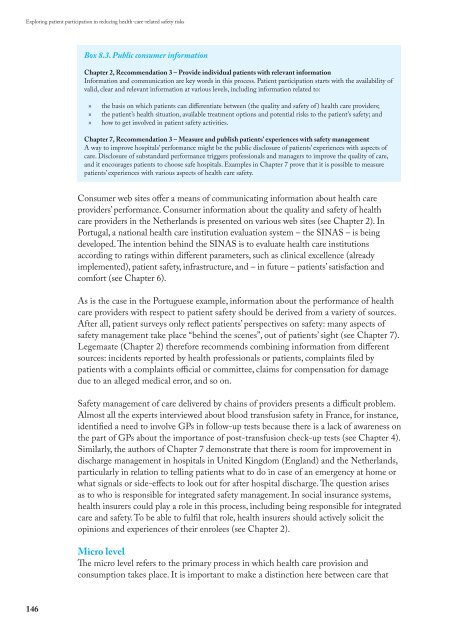Exploring patient participation in reducing health-care-related safety risks
Exploring patient participation in reducing health-care-related safety risks
Exploring patient participation in reducing health-care-related safety risks
You also want an ePaper? Increase the reach of your titles
YUMPU automatically turns print PDFs into web optimized ePapers that Google loves.
<strong>Explor<strong>in</strong>g</strong> <strong>patient</strong> <strong>participation</strong> <strong>in</strong> reduc<strong>in</strong>g <strong>health</strong>-<strong>care</strong>-<strong>related</strong> <strong>safety</strong> <strong>risks</strong><br />
146<br />
Box 8 .3 . Public consumer <strong>in</strong>formation<br />
Chapter 2, Recommendation 3 – Provide <strong>in</strong>dividual <strong>patient</strong>s with relevant <strong>in</strong>formation<br />
Information and communication are key words <strong>in</strong> this process. Patient <strong>participation</strong> starts with the availability of<br />
valid, clear and relevant <strong>in</strong>formation at various levels, <strong>in</strong>clud<strong>in</strong>g <strong>in</strong>formation <strong>related</strong> to:<br />
» the basis on which <strong>patient</strong>s can differentiate between (the quality and <strong>safety</strong> of ) <strong>health</strong> <strong>care</strong> providers;<br />
» the <strong>patient</strong>’s <strong>health</strong> situation, available treatment options and potential <strong>risks</strong> to the <strong>patient</strong>’s <strong>safety</strong>; and<br />
» how to get <strong>in</strong>volved <strong>in</strong> <strong>patient</strong> <strong>safety</strong> activities.<br />
Chapter 7, Recommendation 3 – Measure and publish <strong>patient</strong>s’ experiences with <strong>safety</strong> management<br />
A way to improve hospitals’ performance might be the public disclosure of <strong>patient</strong>s’ experiences with aspects of<br />
<strong>care</strong>. Disclosure of substandard performance triggers professionals and managers to improve the quality of <strong>care</strong>,<br />
and it encourages <strong>patient</strong>s to choose safe hospitals. Examples <strong>in</strong> Chapter 7 prove that it is possible to measure<br />
<strong>patient</strong>s’ experiences with various aspects of <strong>health</strong> <strong>care</strong> <strong>safety</strong>.<br />
Consumer web sites offer a means of communicat<strong>in</strong>g <strong>in</strong>formation about <strong>health</strong> <strong>care</strong><br />
providers’ performance. Consumer <strong>in</strong>formation about the quality and <strong>safety</strong> of <strong>health</strong><br />
<strong>care</strong> providers <strong>in</strong> the Netherlands is presented on various web sites (see Chapter 2). In<br />
Portugal, a national <strong>health</strong> <strong>care</strong> <strong>in</strong>stitution evaluation system – the SINAS – is be<strong>in</strong>g<br />
developed. The <strong>in</strong>tention beh<strong>in</strong>d the SINAS is to evaluate <strong>health</strong> <strong>care</strong> <strong>in</strong>stitutions<br />
accord<strong>in</strong>g to rat<strong>in</strong>gs with<strong>in</strong> different parameters, such as cl<strong>in</strong>ical excellence (already<br />
implemented), <strong>patient</strong> <strong>safety</strong>, <strong>in</strong>frastructure, and – <strong>in</strong> future – <strong>patient</strong>s’ satisfaction and<br />
comfort (see Chapter 6).<br />
As is the case <strong>in</strong> the Portuguese example, <strong>in</strong>formation about the performance of <strong>health</strong><br />
<strong>care</strong> providers with respect to <strong>patient</strong> <strong>safety</strong> should be derived from a variety of sources.<br />
After all, <strong>patient</strong> surveys only reflect <strong>patient</strong>s’ perspectives on <strong>safety</strong>: many aspects of<br />
<strong>safety</strong> management take place “beh<strong>in</strong>d the scenes”, out of <strong>patient</strong>s’ sight (see Chapter 7).<br />
Legemaate (Chapter 2) therefore recommends comb<strong>in</strong><strong>in</strong>g <strong>in</strong>formation from different<br />
sources: <strong>in</strong>cidents reported by <strong>health</strong> professionals or <strong>patient</strong>s, compla<strong>in</strong>ts filed by<br />
<strong>patient</strong>s with a compla<strong>in</strong>ts official or committee, claims for compensation for damage<br />
due to an alleged medical error, and so on.<br />
Safety management of <strong>care</strong> delivered by cha<strong>in</strong>s of providers presents a difficult problem.<br />
Almost all the experts <strong>in</strong>terviewed about blood transfusion <strong>safety</strong> <strong>in</strong> France, for <strong>in</strong>stance,<br />
identified a need to <strong>in</strong>volve GPs <strong>in</strong> follow-up tests because there is a lack of awareness on<br />
the part of GPs about the importance of post-transfusion check-up tests (see Chapter 4).<br />
Similarly, the authors of Chapter 7 demonstrate that there is room for improvement <strong>in</strong><br />
discharge management <strong>in</strong> hospitals <strong>in</strong> United K<strong>in</strong>gdom (England) and the Netherlands,<br />
particularly <strong>in</strong> relation to tell<strong>in</strong>g <strong>patient</strong>s what to do <strong>in</strong> case of an emergency at home or<br />
what signals or side-effects to look out for after hospital discharge. The question arises<br />
as to who is responsible for <strong>in</strong>tegrated <strong>safety</strong> management. In social <strong>in</strong>surance systems,<br />
<strong>health</strong> <strong>in</strong>surers could play a role <strong>in</strong> this process, <strong>in</strong>clud<strong>in</strong>g be<strong>in</strong>g responsible for <strong>in</strong>tegrated<br />
<strong>care</strong> and <strong>safety</strong>. To be able to fulfil that role, <strong>health</strong> <strong>in</strong>surers should actively solicit the<br />
op<strong>in</strong>ions and experiences of their enrolees (see Chapter 2).<br />
Micro level<br />
The micro level refers to the primary process <strong>in</strong> which <strong>health</strong> <strong>care</strong> provision and<br />
consumption takes place. It is important to make a dist<strong>in</strong>ction here between <strong>care</strong> that



